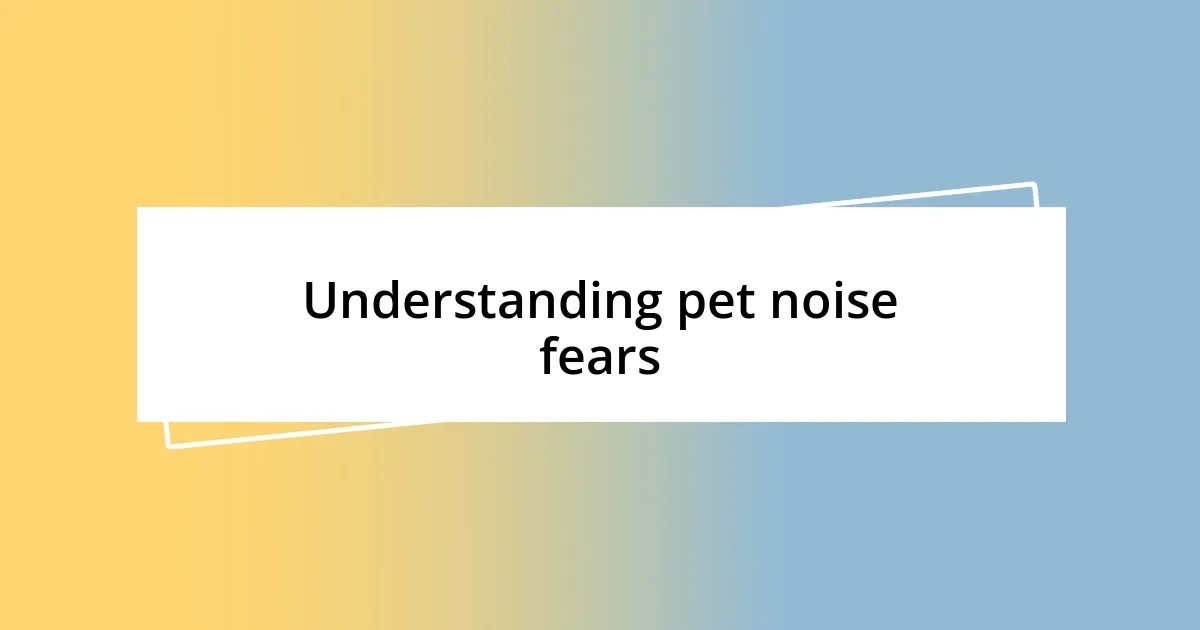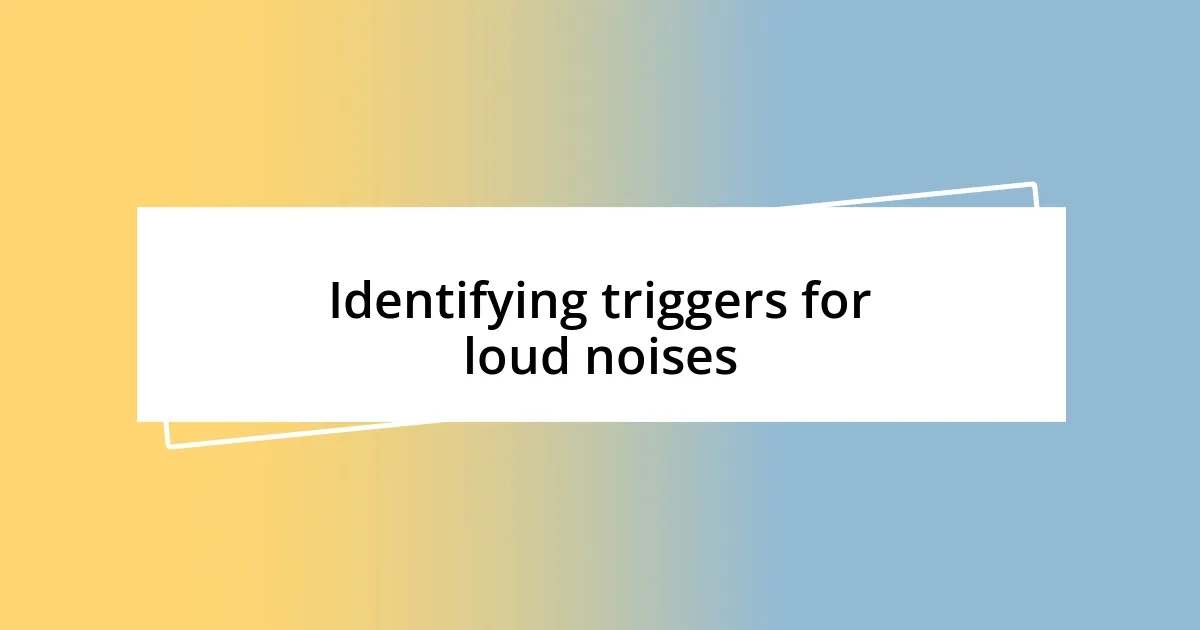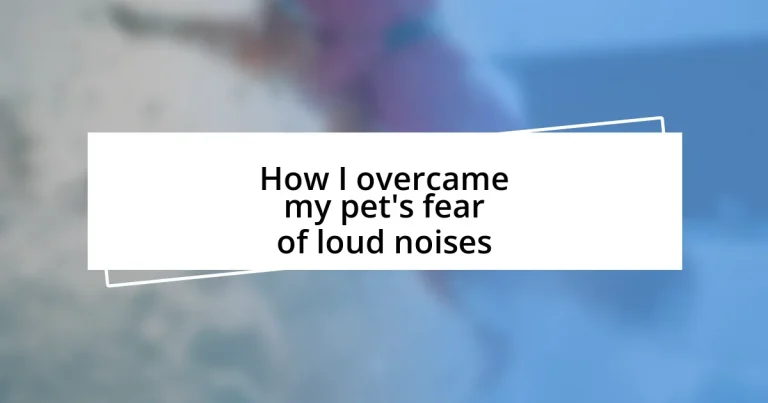Key takeaways:
- Understanding pets’ noise fears is crucial; factors like genetics and past trauma play significant roles in their reactions to loud sounds.
- Gradual desensitization techniques, such as low-volume sound exposure and positive reinforcement, are effective methods for reducing a pet’s fear.
- Utilizing calming products, like sprays and wraps, can significantly help alleviate anxiety during loud events.
- Monitoring progress and adjusting methods based on pet reactions is essential for successful training and building confidence.

Understanding pet noise fears
I’ve often wondered why some pets seem to tremble at the slightest sound, while others remain unfazed. From my experience, fear of loud noises often stems from a combination of genetics, past trauma, or sensory sensitivity unique to each animal. For instance, when my dog, Benny, first heard thunder, his reaction was a mix of confusion and sheer panic, revealing just how deeply ingrained noise fears can be.
Understanding a pet’s background is crucial. I realized that Benny had never been exposed to loud sounds before I adopted him, which likely contributed to his fearful reactions. It sparked a deeper reflection for me—how many pets carry those traumas silently? This connection drives home the point that we must be empathetic towards our furry friends’ experiences, as each fearful response can tell a story of its own.
Through my journey, I’ve discovered that a pet’s fear can also serve as a signal for deeper emotional needs. Have you ever noticed how your pet seeks comfort during a storm? For Benny, curling up beside me was his way of communicating distress, reminding me that a little understanding can go a long way in providing the reassurance they crave.

Identifying triggers for loud noises
Identifying triggers for loud noises is key in helping our pets. I remember the first time Benny startled at the sound of a vacuum cleaner. It was such a seemingly mundane noise, but his reaction was immediate and intense. By observing him, I realized that he had a few specific triggers, including the loud hum of appliances and sudden door slams, which sent him scrambling for cover.
To really understand my pet’s fears, I made note of various situations and sounds that caused him distress. It became a kind of revealing behavior checklist. For instance, when fireworks were on the horizon, I noticed Benny’s ears would perk up, and he’d become unusually restless. Such moments taught me the importance of tuning into his body language, as it held the keys to his hidden triggers.
Throughout my journey, comparing different noises helped me gauge Benny’s fear intensity. In creating a simple table of disturbances, I could easily track his responses. This visual representation became a tool for both understanding and addressing his challenges. It highlighted how each sound affected him differently, enabling me to devise strategies for gradual desensitization.
| Noise Type | Reaction |
|---|---|
| Thunder | Panic, seeking shelter |
| Vacuum Cleaner | Ears back, hiding |
| Fireworks | Restlessness, pacing |
| Door Slams | Startled, running away |

Gradual desensitization techniques for pets
When it came to helping Benny, I found that gradual desensitization was a key part of our journey. I started by playing recordings of sounds that scared him, but at a very low volume. The first time I pressed play, I felt my heart race as he tensed, but I remembered to stay calm and supportive. Over time, I gradually increased the volume, always ensuring Benny was comfortable and had a safe space to retreat to. This careful pacing not only built Benny’s confidence but also reinforced the bond between us.
Here’s a quick guide to some gradual desensitization techniques that worked for us:
- Sound Recordings: Play low-volume recordings of the noises that cause fear, slowly increasing the volume as your pet becomes more comfortable.
- Reward System: Use treats and praise when your pet remains calm during sound exposure. This positive reinforcement builds associations with the feared noise.
- Safe Space: Create a cozy, secure area for your pet to retreat to when feeling anxious. Familiar scents and textures can make it comforting.
- Frequent Breaks: If your pet shows signs of stress, stop the exposure session and give them time to relax before trying again.
- Consistency: Regular, brief exposure to the sounds can help desensitize your pet more effectively than long, overwhelming sessions.
As I incorporated these techniques, I marveled at how resilient pets can be when given the right support. Each step forward was a victory, even if it sometimes felt slow—like the time he actually lay down while the vacuum cleaner was running! That moment made every effort feel worthwhile.

Utilizing calming products for pets
Utilizing calming products for pets can be an essential step in alleviating their fear of loud noises. I remember the first time I tried a calming spray with Benny. At first, I was skeptical. Would it really make a difference? But to my surprise, after a few spritzes around his space, he seemed to relax, and the tension in his body lessened. It was like a light bulb moment for us; sometimes, a little extra help is all they need.
On another note, I explored the world of calming wraps, which cradled Benny like a gentle hug. It’s fascinating how a bit of pressure can create such comfort. I vividly recall the day I put the wrap on him during a thunderstorm. While he initially had that “what is this?” look, within minutes, I noticed him lying down instead of pacing. Have you ever wondered how simple solutions can profoundly impact our pets’ emotional state? It’s so rewarding to witness that transformation.
Additionally, I learned about calming chews, which might seem like a snack but are packed with natural ingredients aimed at reducing anxiety. One evening, I offered Benny a chew right before the neighborhood fireworks started. Sure enough, I saw him munching away, and I felt relieved knowing I had given him something soothing while the chaos unfolded outside. Seeing him calmly chewing in the face of his fears taught me that sometimes, little adjustments can yield significant changes for our furry friends.

Training exercises to reduce fear
To effectively reduce my pet Benny’s fear of loud noises, I turned to training exercises that incorporated positive reinforcement. One method I found particularly effective was pairing sound exposure with playtime. I remember tossing Benny’s favorite toy as I gradually added low-volume recordings of unsettling noises. Watching him chase after the toy while also hearing the sounds helped establish a new, positive association. Have you ever noticed how a favorite game can take the mind off stress? This certainly worked wonders for Benny and made our sessions more enjoyable.
In my experience, practicing “Look at That” training helped Benny to focus on a cue rather than the source of his anxiety. I would calmly point out a sound—sometimes even just using my voice—when Benny was alert but not overly stressed. I saw the gears turning in his mind as he began to associate my calm demeanor with the noises, which slowly diminished his reactive state. There were moments when I felt a mix of hope and frustration, as it took time, but with each successful session, I felt us moving forward together.
Another technique I found valuable was engaging in gradual exposure during everyday activities. I intentionally included sounds like doorbells or vacuum cleaners in our routine while walking him. Initially, I would go for short walks near the source of the noise, rewarding him with treats whenever he remained relaxed. It was during one of these walks, with a distant motorcycle rumbling by, that I realized how far we had come—he merely glanced, then continued sniffing the grass, as if the noise were merely background chatter. That particular moment filled me with such pride, reinforcing my belief that consistent training truly reshapes our pets’ responses to fear.

Monitoring progress and adjusting methods
Monitoring progress is vital in understanding how well the methods I’ve chosen are working. After a couple of weeks of training with Benny, I started to notice subtle changes in his behavior. For instance, during a particularly loud thunderstorm, instead of hiding under the couch as he usually would, he opted to curl up next to me, seemingly seeking comfort rather than fear. Have you ever experienced that shift in your pet’s demeanor that made you feel hopeful? It’s like witnessing a small victory that fuels your determination to continue.
As I observed Benny, I found it crucial to adjust my approach based on his reactions. There were times when I realized the sound exposure was too much for him. In those moments, I dialed back the volume and increased the frequency of breaks during our sessions. This trial-and-error process required patience, but it offered me additional insights into his comfort zone. I began to think about how often we overlook the need for flexibility in our training — isn’t it easy to get stuck in a rigid routine?
Documenting each session also became a cornerstone of my strategy. I kept track of what worked and what didn’t in a simple notebook. There was something therapeutic about reflecting on those little wins, like the day Benny stayed calm through a nearby construction noise. By jotting down his progress, I could pinpoint what methods were most effective and when to reinforce them. Have you ever found that keeping a record provides clarity in your approach? This method not only deepened my connection with Benny but also established a roadmap for our future training efforts.














